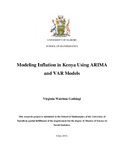| dc.contributor.author | Gathingi, Virginia W | |
| dc.date.accessioned | 2014-08-04T08:44:56Z | |
| dc.date.available | 2014-08-04T08:44:56Z | |
| dc.date.issued | 2014-07 | |
| dc.identifier.citation | Degree Of Masters Of Science In Social Statistics, University Of Nairobi, 2014 | en_US |
| dc.identifier.uri | http://hdl.handle.net/11295/73575 | |
| dc.description.abstract | Inflation is an important indicator of economic activity and is used by decision makers to plan
economic policies. This paper is based on modeling inflation over the period 2005-2013 using
two auto regressive models; Autoregressive Integrated Moving Average (ARIMA) model and
the Vector Autoregression (VAR) model. ARIMA model is used to fit historical CPI time series
expressed in terms of past values of itself plus current and lagged values of error term resulting
to the model (1,1,0). Data for the last six months is used to evaluate the performance of the
prediction. VAR model is used to investigate the effect of money supply, Murban oil prices and
exchange rate on inflation rate over the same period. Unit root test (Augmented Dickey- Fuller
test) has been exploited to check the integration order of the variables. A cointegration analysis
with the four variables is employed. Study adopted Johansen test. Findings indicated that both
trace test and max Eigen value static showed that individual variables are cointegrated with
inflation at 5% significant level. This led to estimation of a Vector Error Correction Model
(VECM). Findings showed that there is no long run causality running from the independent
variables to inflation. In addition, money supply and exchange rate has no short run causality
whereas a four lag Murban oil price had short run causality to inflation. | en_US |
| dc.language.iso | en | en_US |
| dc.publisher | University of Nairobi | en_US |
| dc.title | Modeling Inflation in Kenya Using ARIMA and VAR Models | en_US |
| dc.type | Thesis | en_US |
| dc.type.material | en_US | en_US |


